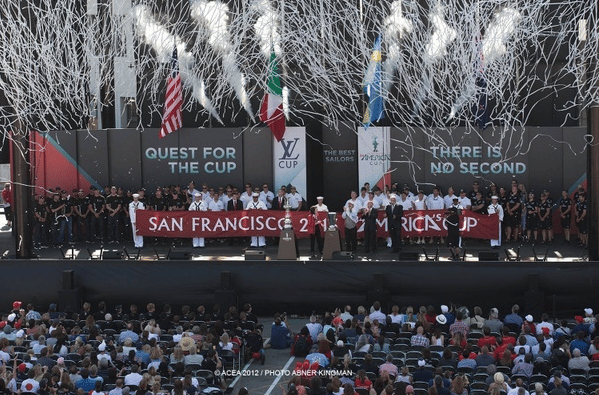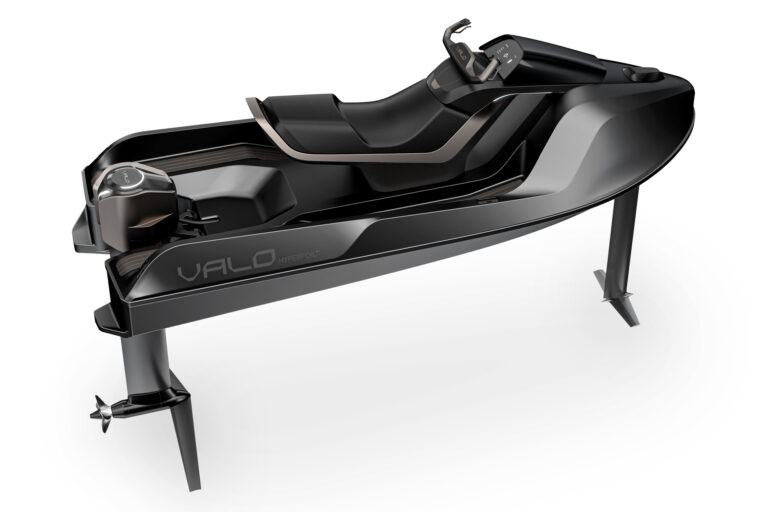
Opening Day America’s Cup
But how did we get here?
As we reported in the July issue, Artemis Racing—the Challenger of Record (CoR) for the 34th America’s Cup—suffered a boat-breaking capsize on May 9 on San Francisco Bay, which tragically claimed the life of double-Olympic medalist Andrew “Bart” Simpson (GBR; 36). All Cup-related sailing ceased in the wake of the Artemis accident, with all teams publicly throwing support behind the concept of trying to make “AC34” a safer event for all sailors. Iain Murray, the Regatta Director for AC34, spearheaded a “review committee” that looked into the tragedy and which issued a list of 37 “safety recommendations” that were (supposedly) designed to bolster the overall safety of each team’s sailing program.
Murray has likely learned the true meaning of the cliché about the devil being in the details. According to Murray’s telling of the story, all teams embraced his 37-point list, with certain key (antipodean) factions allegedly going so far as to assure the Australian national that “you won’t get any push back from us”.
Here’s where it gets technical: Bundled in with Murray’s 37-point list were two items that have become extremely hot in the past two weeks, namely an effective change to the AC72 class rule pertaining to how the boats control their pitch (bow/stern trim) while flying on their hydrofoils. When the AC72 class rule was first presented, no one was envisioning fully foiling boats, as there was clear language forbidding the use of movable flaps on the trailing edge of each rudder’s hydrofoil (think flaps on an airplane wing). Emirates Team New Zealand (ETNZ) was the first team to crack the foiling code, bolstered no doubt by the fact that the team mysteriously (some say “suspiciously”) managed to hire Gino Morelli and Pete Melvin (of the yacht-design group Morrelli and Melvin), who were integrally involved in authoring the AC72 class rule.
According to sources, ETNZ (and Luna Rossa, who bought a set of first-generation AC72 plans from ETNZ and spent time training with the Kiwis in Auckland last winter) managed to overcome the pitch-control issue by enclosing their daggerboards in a cassette-like assembly, which can be racked and canted to produce the right boat trim. This breakthrough allowed the Kiwis (and the Italians) to foil their powerful catamaran within mere days of the teams splashing their new boats. Oracle and Artemis challenged the Kiwi’s daggerboard system last fall with the International Jury, who deemed the system to be compliant with AC72 class rules. This was tough news for the American and Swedish teams who had not designed their first-generation boats to fully foil, thus putting the Defender and the CoR at a distinct disadvantage.
Still, both Oracle and Artemis pressed forward with their first-generation boats, taking steps to modify the boats for increased lift. Oracle’s first-generation boat flew on ill-balanced foils until October 16, 2012, when she dramatically capsized and broke apart on San Francisco Bay. [The team was able to rebuild their first boat and incorporate 2.0 innovations and design leaps into their second-generation boat, and both boats are now sailing on San Francisco Bay.] Artemis’ non-foiling “solution” proved disastrous in May when Simpson died, but the team is supposedly working on a foil-friendly second-generation boat.
Remember those two contentious safety recommendations? Bundled into that list were two points that govern an AC72’s rudder system, namely permission to sail with “rudder elevators” (a system that changes the angle of attack of the trailing edge of the rudder) and permission to use rudder foils that extend beyond the yacht’s maximum beam. Oracle and Artemis claim that these rule changes increase the safety of the boats, while ETNZ and Luna Rossa claim that this is nothing more than a last-minute attempt to short-cut class rules (and the Protocol governing AC34) in an effort to reduce the challenges of foiling. Moreover, ENTZ and Luna Rossa claim that these changes put them at a distinct disadvantage, as their clever daggerboard system forced these teams to make certain design sacrifices (likely weight and aerodynamics) in order to fly…design sacrifices that Oracle and Artemis can avoid, thus giving the Defender and the CoR potential straight-line speed advantages.
Currently, ETNZ and Luna Rossa have both lodged protests against Regatta Director Murray, arguing that rudder elevators (and rudder max beam measurements) are performance enhancers, not safety considerations. Moreover, the teams are protesting the fact that Murray has operated outside of his authority as Regatta Director by changing the design rule without navigating the proper channels. Things get spicy as the first starting guns for the newly re-envisioned Louis Vuitton Cup (which determines the team that will meet Oracle on the water for the 34th America’s Cup) begin firing on July 7, while the International Jury will not hear ETNZ’s protests until Monday, July 8 (no date has been set for Luna Rossa’s protest). Both ETNZ and Luna Rossa have threatened to run this issue up the legal flag pole—potentially spelling a trip back to the New York Supreme Court—while the Defender and the CoR have said precious little about the situation.
Murray, however, has been far more vocal in his retort to ETNZ and Luna Rossa.
Overshadowing the entire event is the legal (and political) need for the regatta to secure a Marine Event Permit from the United States Coast Guard, which was issued last week on the tails of Murray’s 37-point safety list. According to the latest reports, Murray has threatened that, without universal acceptance of his recommendations, he will go back to the USCG and argue that the regatta is unsafe, a move that could potentially derail the entire America’s Cup.
So, is the sky falling in the America’s Cup world? No…but it’s fair to say that we’ve entered a distinctly “America’s Cup” game of brinksmanship that, in political/historical terms, could be equated to the Cuban Missile Crisis. If the playing field sounds lopsided, it’s vital to remember that the entire concept behind the Americas Cup is essentially a sophisticated game of “King of the Hill”, fought out by billionaires, with the Defender able to select the hill, the terms of engagement, the types of equipment used, and myriad other details. Fair it’s not, but entertaining (if not “enveloping”) it certainly is! While the whole sailing world hopes that cool heads prevail, much will be in flux until ETNZ and Luna Rossa’s protests can be heard.
LVC racing starts this weekend, with an AC72 boat parade and some speed runs, as well as some match racing between ETNZ and Luna Rossa. The racing schedule had to be redrafted in light of Artemis’ accident (they will not be sailing until late July at the earliest…if not sometime in August), so points don’t actually start getting counted until early August. Until then, there’s sadly not much more that anyone can do except wait for news and enjoy the fantastic imagery of these amazing speed machines flying around on San Francisco Bay…just be sure to keep your foulies close by, as San Francisco Bay is notorious for delivering big wind and waves in the summer, and the Auld Mug can always be counted on to deliver her own political storms.









